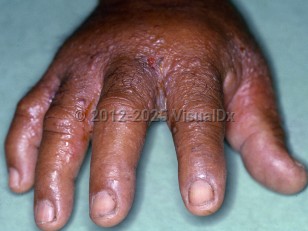Fish typically associated with this type of reaction include scombroid fish, ie, fish having dark meat such as tuna, mackerel, and bonito. Other fish that do not have dark meat (nonscombroid fish) but that have also been implicated are mahi mahi, salmon, sardines, and bluefish.
Onset of symptoms is usually 30-60 minutes after ingestion of the fish, although it may be as fast as 5-10 minutes. The initial sensation is that of flushing with a feeling of warmth. Duration of symptoms is around 3 hours but may be longer.
Signs and symptoms include the following:
- Facial flushing
- Erythematous rash
- Burning sensation in the mouth
- Palpitations
- Tightness in the chest and shortness of breath
- Nausea, vomiting, and diarrhea
- Abdominal cramps
- Headache and dizziness
- Collapse, due to hypotension
The severity of symptoms is related to the level of histamine in the fish and can be categorized as follows.
- Slight: 8-40 mg histamine
- Moderate: > 40 mg histamine
- Severe: > 100 mg histamine
It is important to note that scombroid fish poisoning is not an allergic reaction to fish but a reaction to the toxins produced in improperly stored fish. All individuals can be affected by this type of fish poisoning, but those especially susceptible are the elderly and individuals taking isoniazid medication.
Swiss cheese and certain other foods can cause a similar reaction.



